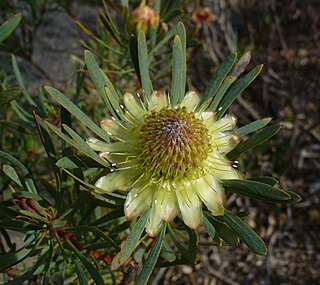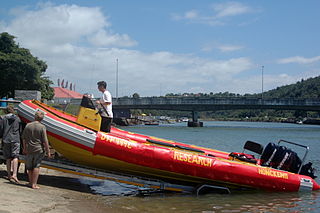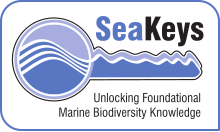
Kirstenbosch is an important botanical garden nestled at the eastern foot of Table Mountain in Cape Town. The garden is one of 10 National Botanical Gardens covering five of South Africa's six different biomes and administered by the South African National Biodiversity Institute (SANBI). Prior to 1 September 2004, the institute was known as the National Botanical Institute.

The South African Institute for Aquatic Biodiversity (SAIAB), is involved in research, education and in applications of its knowledge and research to African fish fauna, for either economic or conservation benefit.

Protea laurifolia, also known as the grey-leaf sugarbush, is a shrub from South Africa. It is native to the Cape Provinces of South Africa.

Protea scolymocephala, also known as the thistle protea or thistle sugarbush, is a flowering plant from the genus Protea native to South Africa.
SABAP2 is the acronym for the Southern African Bird Atlas Project 2, which is the follow-up to the Southern African Bird Atlas Project. The first atlas project took place from 1987 to 1991. The current project was a joint venture between the Animal Demography Unit at the University of Cape Town, BirdLife South Africa, and the South African National Biodiversity Institute (SANBI). Following the closure of the Animal Demography Unit, the project is now managed by the FitzPatrick Institute of African Ornithology, University of Cape Town. The project aims to map the distribution and relative abundance of birds in southern Africa, and the original atlas area included South Africa, Lesotho, and Eswatini, although since 2012 the project has expanded to include Namibia, Botswana, Zimbabwe and Mozambique. SABAP2 was launched on 1 July 2007. The field work for this project is conducted by more than 1700 volunteers, known as citizen scientists – they collect the data in the field at their own cost and in their own time. As such they make a huge contribution to the conservation of birds and their habitat.

The South African Environmental Observation Network (SAEON) is a science network of people, organisations and, most importantly observation platforms, that perform Long-Term Ecological Research (LTER) in South Africa and its surrounding oceans. The SAEON is of global importance as an innovative approach in ecology to understand environmental change and to determine the impact of anthropogenic forces at multiple scales but it is a remarkably complex challenge to statistically discern between ubiquitous natural variability and exogenous forcing. The SAEON constitutes a national government response to the World Summit on Sustainable Development (Earth Summit 2002) and is a component of the GEO (Group on Earth Observations). The SAEON has become the leader in environmental science and observation in South Africa, but has been criticised for taking a long time to establish, a situation which was inevitable in view of SAEON's multiple stakeholder corps. It has also been raised that the cost of replicated experimental treatments across SAEON sites will be high.

Protea acaulos, also known as the common ground sugarbush, is a flowering plant found in the southwestern Cape Region, South Africa. It is also simply known as ground protea; in the Afrikaans language it is known as an aardroos.

iSpot is a website developed and hosted by the Open University with funding from the Open Air Laboratories (OPAL) network with an online community intended to connect nature enthusiasts of all levels.
The South African National Biodiversity Institute (SANBI) is an organisation tasked with research and dissemination of information on biodiversity, and legally mandated to contribute to the management of the country's biodiversity resources.

The Marine biodiversity of South Africa is the variety of living organisms that live in the seas off the coast of South Africa. It includes genetic, species and ecosystems biodiversity in a range of habitats spread over a range of ecologically varied regions, influenced by the geomorphology of the seabed and circulation of major and local water masses, which distribute both living organisms and nutrients in complex and time-variable patterns.
The Save Our Seas Foundation is a philanthropic organization committed to protecting the world's oceans. It was founded in Geneva, Switzerland, on 23 September 2003.

Protea namaquana, also known as the Kamiesberg sugarbush, is a flowering plant which belongs to the genus Protea. The plant is endemic to the southwestern Cape Region of South Africa, in particular the Kamiesberg mountains of Namaqualand in the Northern Cape province. The species has a worldwide distribution of only 18 km2. It is regarded as critically endangered. In the Afrikaans language it has the vernacular name is Kamiesbergsuikerbos.

Protea pudens, also known as the bashful sugarbush, is a low-growing, groundcover-like, flowering shrub in the genus Protea. It is only found growing in the wild in a small area in the Western Cape province of South Africa.

Protea susannae, also known as stink-leaf sugarbush, is a flower-bearing shrub of the genus Protea. The plant is endemic to the southwestern Cape Region of South Africa.
The Biodiversity of South Africa is the variety of living organisms within the boundaries of South Africa and its exclusive economic zone. South Africa is a region of high biodiversity in the terrestrial and marine realms. The country is ranked sixth out of the world's seventeen megadiverse countries, and is rated among the top 10 for plant species diversity and third for marine endemism.
Leucadendron sheilae, the Lokenberg conebush, is a flower-bearing shrub that belongs to the genus Leucadendron and forms part of the fynbos, a South African biogeographical region. The plant is native to the Western and Northern Capes, where it occurs at Lokenberg in the Bokkeveld Mountains. The plant grows mainly in hard sandstone sand on level crests at altitudes of 600 to 900 metres (2,000–3,000 ft). In Afrikaans it is known as Lokenberg-tolbos.

Zyrphelis decumbens is a species of perennial plant from the Bainskloof Mountains in the Cape Provinces of South Africa.
Ursinia punctata is a species of plant belonging to the daisy family. It is found growing in South Africa, where it has a wide distribution.
Cheiridopsis turbinata is a succulent plant from South Africa.
Cheiridopsis umdausensis is a species of succulent plant from South Africa.












